Engaging in a running routine is not just about physical fitness; it's an invitation to a transformative journey that extends far beyond the pavement. For aspiring runners, the benefits are not solely measured in miles or minutes but in the profound impact on both body and mind.
As you lace up your running shoes, envision a path toward a stronger, healthier version of yourself. The cardiovascular improvements are just the beginning. Running builds a resilient mindset, offering mental clarity and a surge of positivity with each stride. It's a journey of self-discovery, where the rhythm of your feet creates a symphony of empowerment.
Embrace the challenge with a sense of excitement, knowing that every step is a victory, a testament to your commitment. Picture the finish line not as an end but as a marker of your evolving strength and endurance. With each run, you're not just covering distance; you're breaking barriers, shattering doubts, and unlocking untapped potential.
Running is a celebration of your body's capability and an opportunity to foster a deep connection with your own resilience. It's a reminder that you are capable of more than you may have thought. So, let the asphalt be your canvas, the shoes your brush, and the open road your masterpiece. The running community welcomes you with open arms, ready to witness and applaud every step of your empowering journey. The road ahead is not just a route; it's an adventure of self-discovery, personal triumphs, and the joy of embracing a healthier, more vibrant life.
The following are some exercises to help strengthen and condition your body to get the best out of your running and reduce the risk of running related injury. You can also download the PDF version here
LUNGE STEP
The step lunge is particularly advantageous for runners due to its ability to strengthen specific muscle groups involved in running. This exercise targets the quadriceps, hamstrings, and glutes, which are essential for propelling the body forward during running. Additionally, by emphasizing balance and stability, the step lunge contributes to a more solid posture, helping runners maintain efficient form and reduce the risk of running-related injuries.
The range of motion provided by the step lunge is also beneficial for runners as it helps improve flexibility in the hip and knee joints. This is crucial for movement efficiency during running and can contribute to a smoother and more natural stride.
Furthermore, by incorporating the step lunge into their training routine, runners can vary their exercises, preventing monotony and promote balanced muscle development. This is crucial for endurance and injury prevention, allowing runners to achieve more consistent and lasting performance in their activities.

-
Beginners:
Sets: 2 to 3 sets per exercise
Repetitions: 10 to 15 repetitions per set
Rest: About 1 to 2 minutes between sets
-
Intermediates:
Sets: 3 to 4 sets per exercise
Repetitions: 8 to 12 repetitions per set
Rest: 1 to 2 minutes between sets
-
Advanced:
Sets: 4 or more sets per exercise
Repetitions: 12 to 20 repetitions per set
Rest: 1 to 2 minutes between sets
THRUSTER
The thruster exercise offers significant benefits for runners by strengthening both the lower and upper body. Combining squatting with an overhead press, it develops explosive leg strength crucial for propelling the body during running. Additionally, it improves coordination, stability, and biomechanical efficiency. The key muscles involved include quadriceps, hamstrings, glutes, deltoids, triceps, and the core, providing a comprehensive and integrated workout for runners.
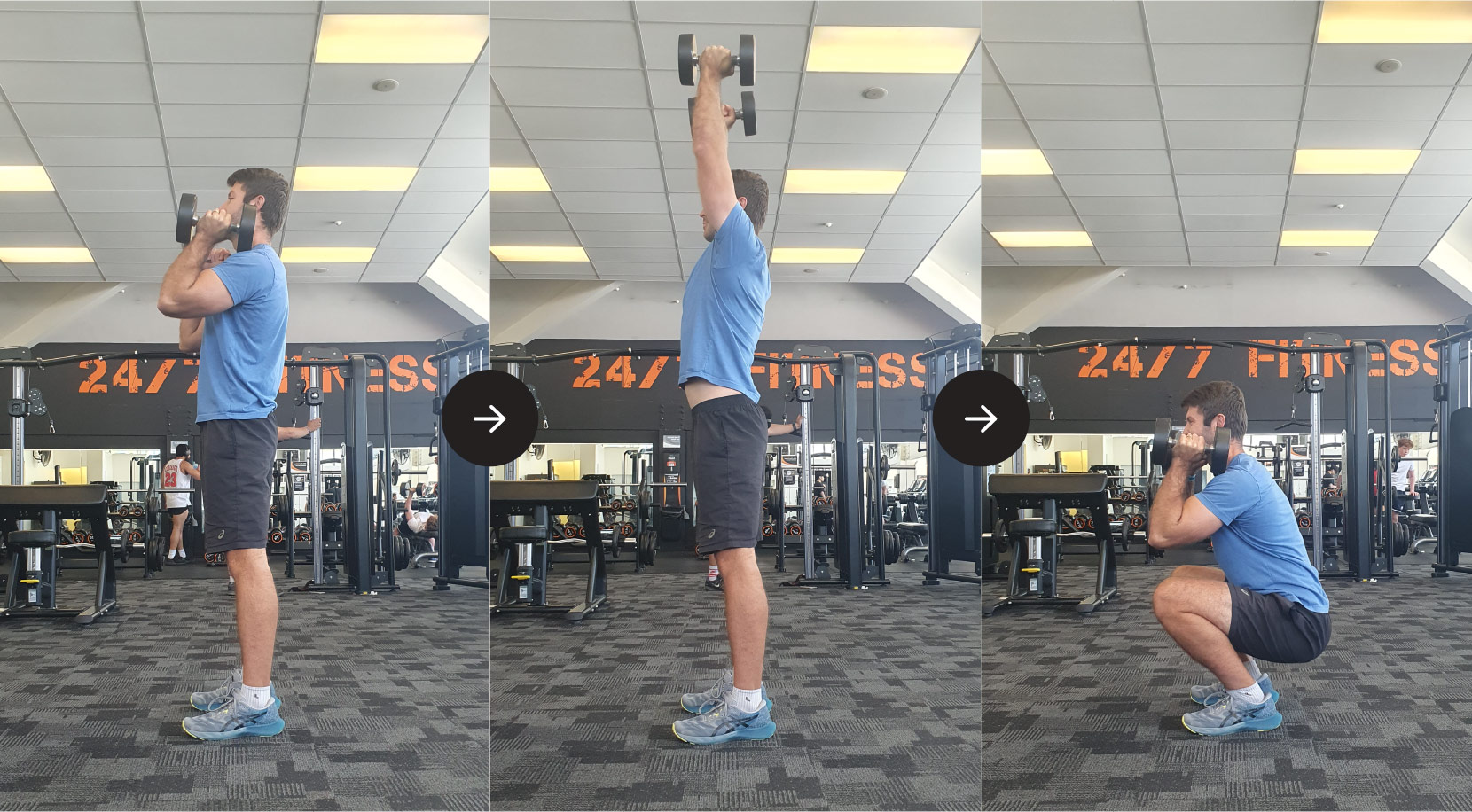
-
Beginners:
Sets: 2 to 3 sets per exercise
Repetitions: 12 to 15 repetitions per set
Rest: About 1 to 2 minutes between sets
-
Intermediates:
Sets: 3 to 4 sets per exercise
Repetitions:10 to 12 repetitions per set
Rest: 1 to 2 minutes between sets
-
Advanced:
Sets: 4 or more sets per exercise
Repetitions: 12 to 20 repetitions per set
Rest: 1 to 2 minutes between sets
Sumo Squat
The sumo squat is a valuable addition for runners. By widening the stance, it intensifies engagement of the inner thigh and glute muscles, strengthening crucial areas for stability and propulsion during running. This movement recruits the quadriceps, hamstrings, adductors, and glutes comprehensively, providing a solid foundation for power in each stride. This squat variation also stimulates core stabilization, contributing to better posture during running. Incorporating sumo squats into training can enhance functional strength and muscular endurance, key elements for runners aiming for consistent performance.

-
Beginners:
Sets: 2 to 3 sets per exercise
Repetitions: 12 to 15 repetitions per set
Rest: About 1 to 2 minutes between sets
-
Intermediates:
Sets: 3 to 4 sets per exercise
Repetitions:10 to 12 repetitions per set
Rest: 1 to 2 minutes between sets
-
Advanced:
Sets: 4 or more sets per exercise
Repetitions: 12 to 20 repetitions per set
Rest: 1 to 2 minutes between sets
The Leg Curl Machine
The leg curl machine, specifically the seated leg curl, holds significant benefits for runners. By flexing the knee against resistance, it targets and strengthens the hamstrings in the back of the thigh. This specific action is crucial for balancing muscular strength in the legs, providing additional support during the propulsion phase in running. Strengthening the hamstrings not only enhances movement efficiency but also contributes to injury prevention, a vital aspect for runners who heavily rely on these muscles for propulsion and stability during training. Incorporating the leg curl machine into training helps build a strong muscular foundation, essential for consistent and enduring performance in running.
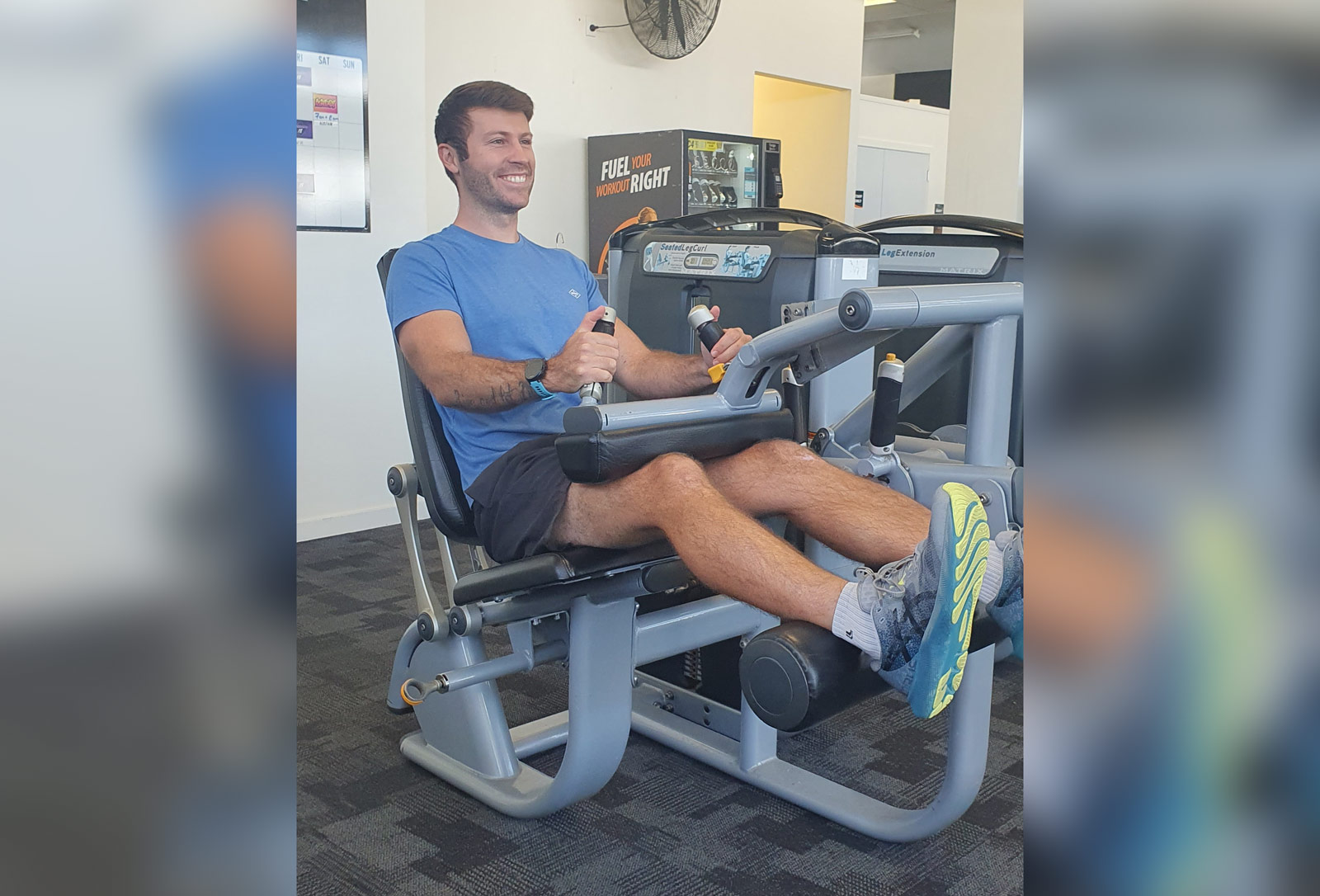
-
Beginners:
Sets: 2 to 3 sets
Repetitions: 12 to 15 repetitions per set
Rest: About 1 to 2 minutes between sets
-
Intermediates:
Sets: 3 to 4 sets
Repetitions:10 to 12 repetitions per set
Rest: 1 to 2 minutes between sets
-
Advanced:
Sets: 4 or more sets
Repetitions: 20 to 40 repetitions per set
Rest: 1 to 2 minutes between sets
STEP – UP
The exercise of stepping up and down from a box with one leg, known as a step-up, primarily activates leg muscles, including quadriceps, hamstrings, glutes, and calves. This movement also engages the core for stability. The step-up is beneficial for runners as it mimics the running motion, strengthening specific muscles used during propulsion. This helps improve strength, stability, and movement efficiency—key elements for a more consistent and resilient performance in running.
To progress, gradually increase the load or the height of the box. Maintaining proper form and challenging one's limits is crucial for muscle development
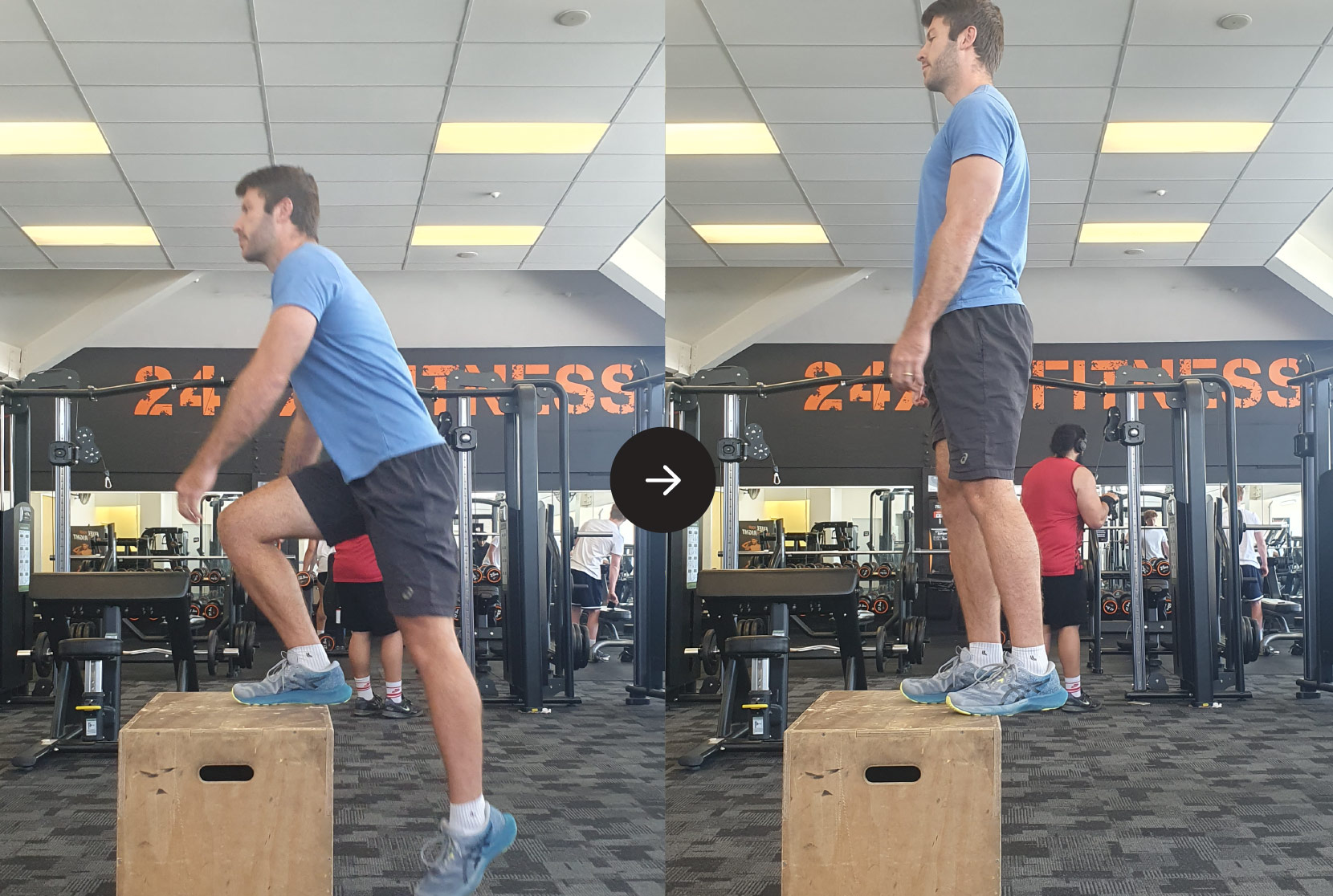
-
Beginners:
Sets: 2 to 3 sets
Repetitions: 12 to 15 repetitions per set
Rest: About 1 to 2 minutes between sets
-
Intermediates:
Sets: 3 to 4 sets
Repetitions:10 to 12 repetitions per set
Rest: 1 to 2 minutes between sets
-
Advanced:
Sets: 4 or more sets
Repetitions: 15 to 20 repetitions per set
Rest: 1 to 2 minutes between sets
Hip Bridge
The hip bridge is an exercise that primarily activates the glutes, hamstrings, and lower back muscles. Its function for runners lies in strengthening these areas, improving core stability, and enhancing leg movement efficiency. This improvement in strength and stability contributes to a more solid running posture, reducing the risk of injuries and optimizing performance. Additionally, the hip bridge is effective in developing gluteal power, a crucial component for propulsion during running.
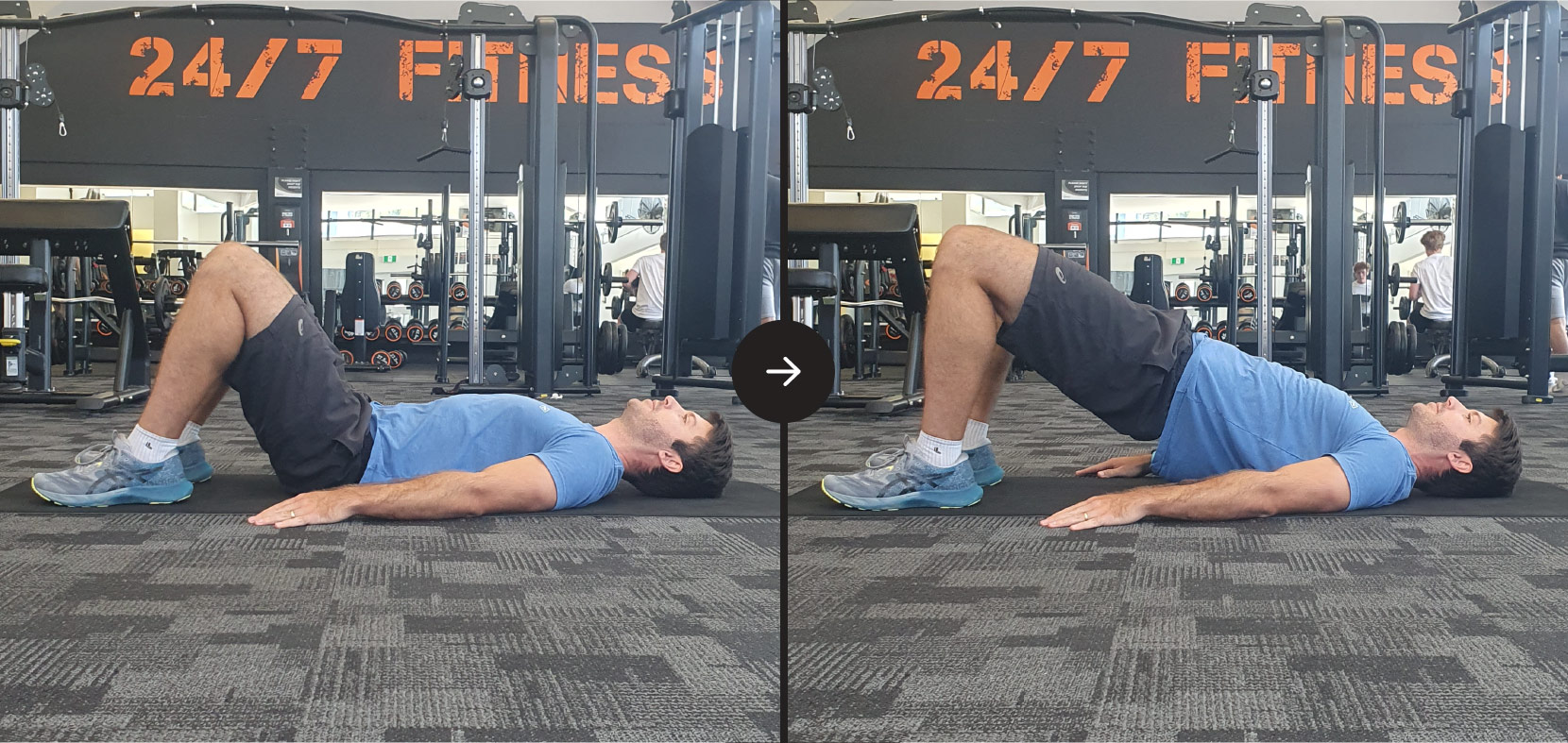
-
Beginners:
Sets: 2 to 3 sets
Repetitions: 12 to 15 repetitions per set
Rest: About 1 to 2 minutes between sets
-
Intermediates:
Sets: 3 to 4 sets
Repetitions:10 to 12 repetitions per set
Rest: 1 to 2 minutes between sets
-
Advanced:
Sets: 4 or more sets
Repetitions: 6 to 10 repetitions per set
Rest: 1 minute between sets
ABDOMINAL INFRA
The leg lift, or "abdominal infra," primarily targets the lower abdominal muscles, including the rectus abdominis and oblique muscles. For runners, this exercise aids in specific strengthening of the abdominal region, enhancing core stability, and promoting a more efficient running posture. Additionally, strengthening these muscles can help prevent injuries and provide additional support during the propulsion phase, contributing to a more consistent and resilient performance in running.
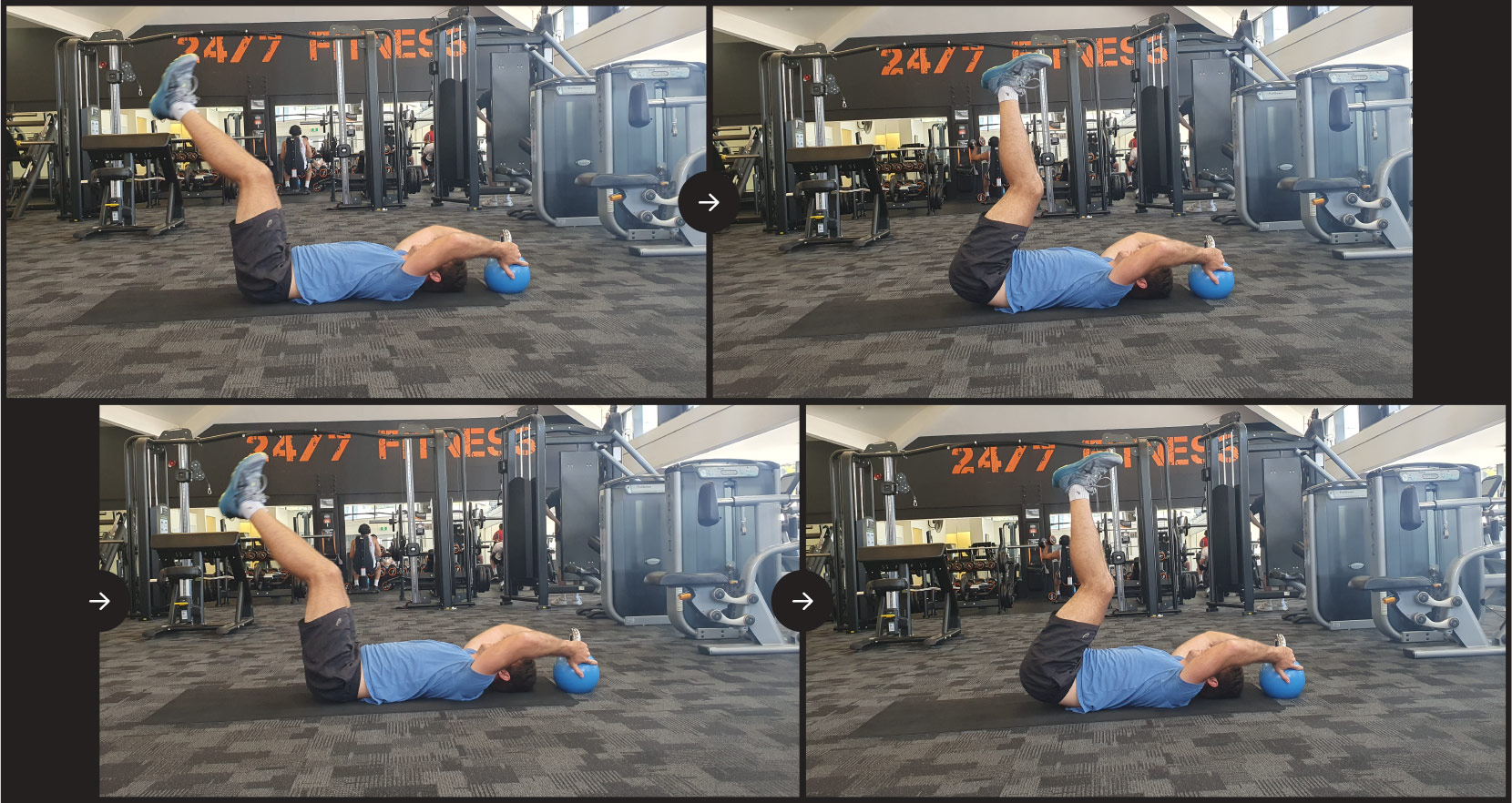
-
Beginners:
Sets: 2 to 3 sets
Repetitions: 10 to 15 repetitions per set
Rest: About 2 minutes between sets
-
Intermediates:
Sets: 3 to 4 sets
Repetitions:15 to 25 repetitions per set
Rest: 1 to 2 minutes between sets
-
Advanced:
Sets: 4 or more sets
Repetitions: 25 to 30 repetitions per set
Rest: 1 minute between sets
